新概念英语第一册Lesson 117 Tommy's breakfast 课件(共47张PPT)
文档属性
| 名称 | 新概念英语第一册Lesson 117 Tommy's breakfast 课件(共47张PPT) | 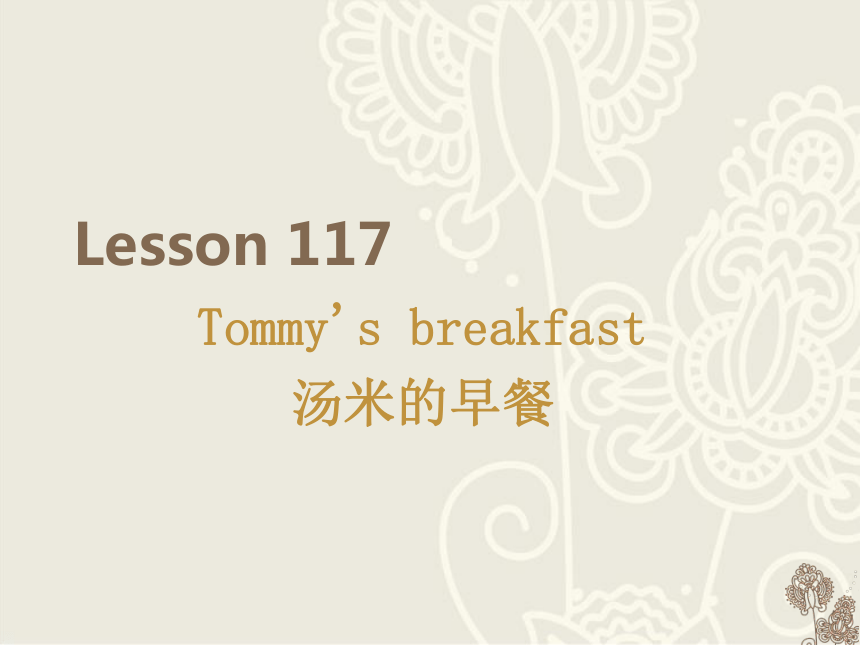 | |
| 格式 | ppt | ||
| 文件大小 | 2.0MB | ||
| 资源类型 | 教案 | ||
| 版本资源 | 新概念英语 | ||
| 科目 | 英语 | ||
| 更新时间 | 2024-03-08 08:11:46 | ||
图片预览

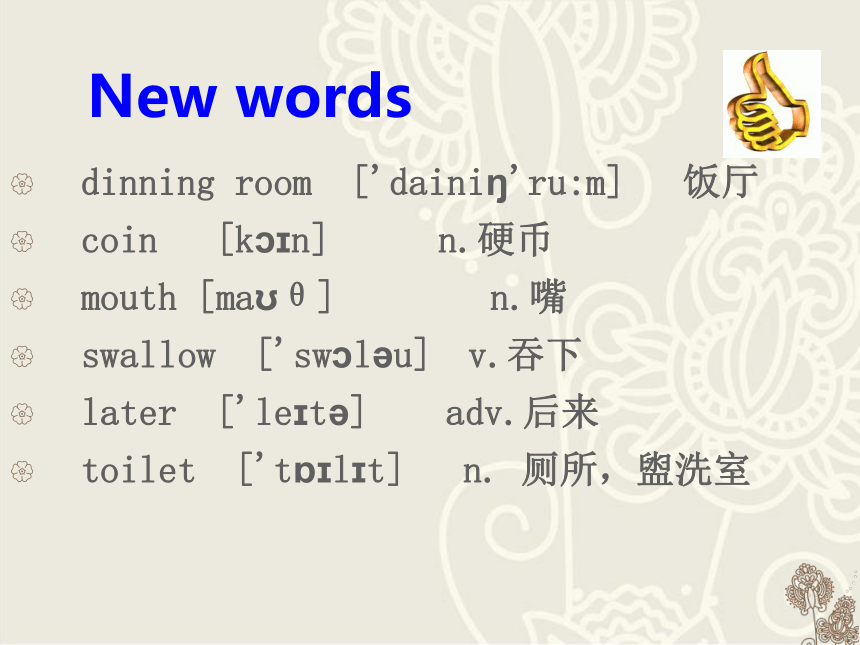
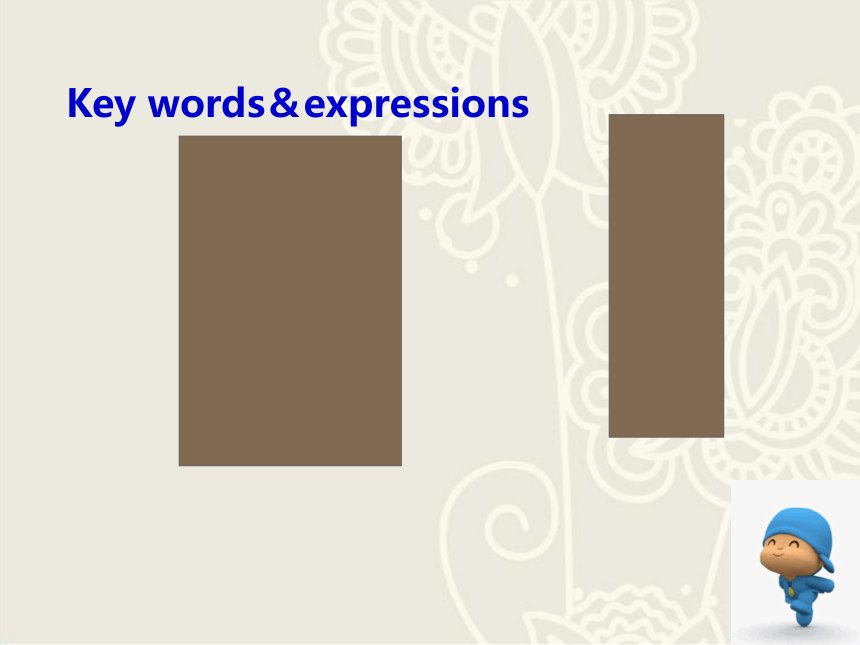



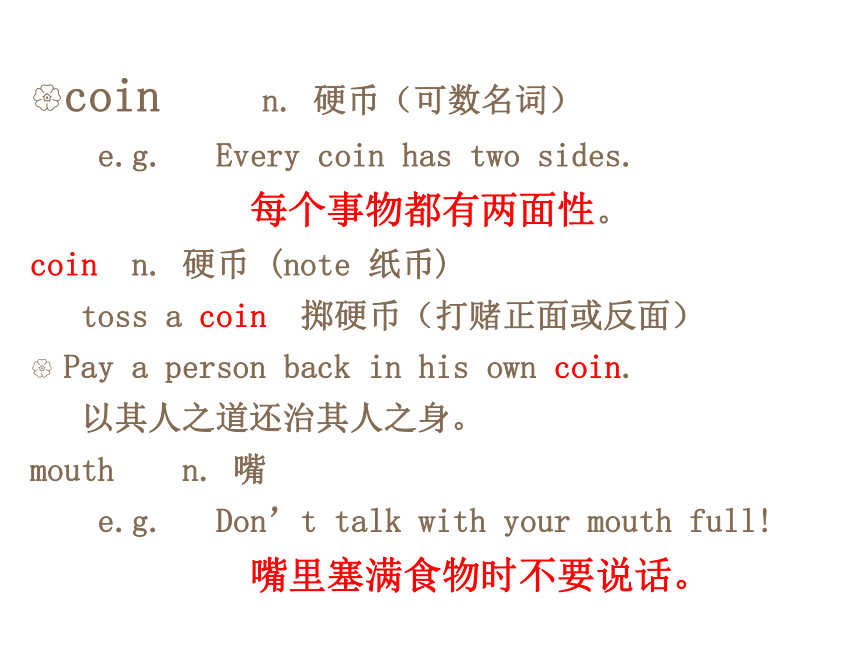
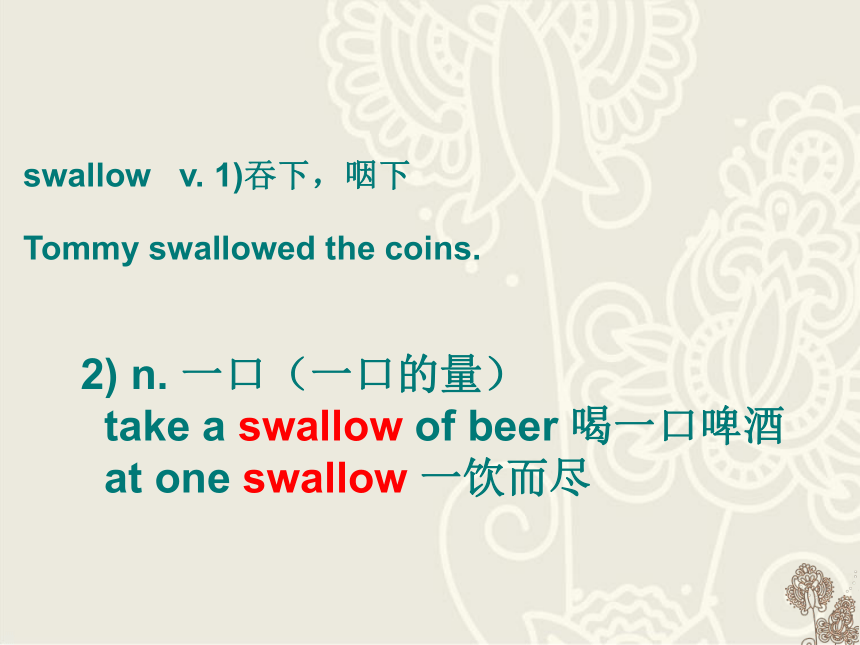
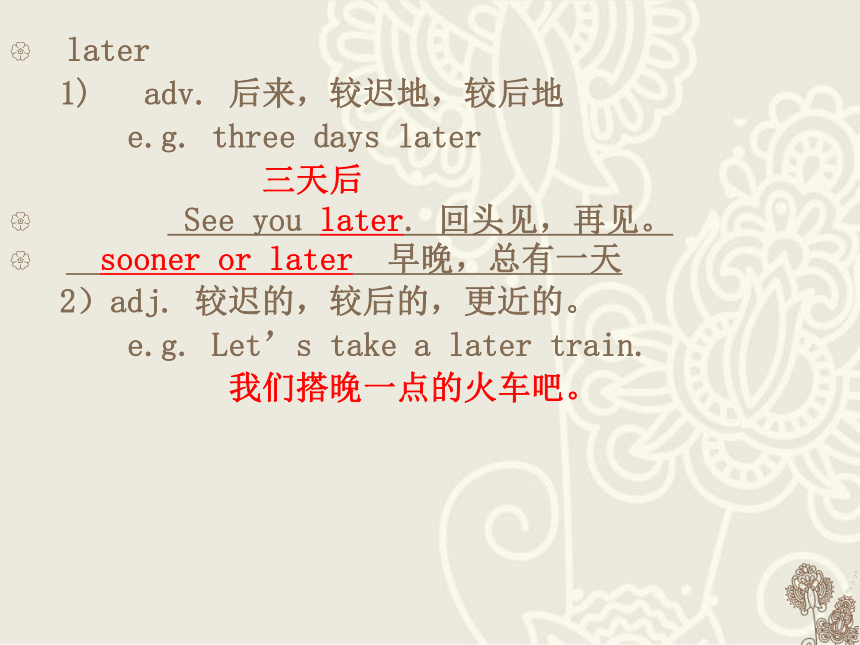
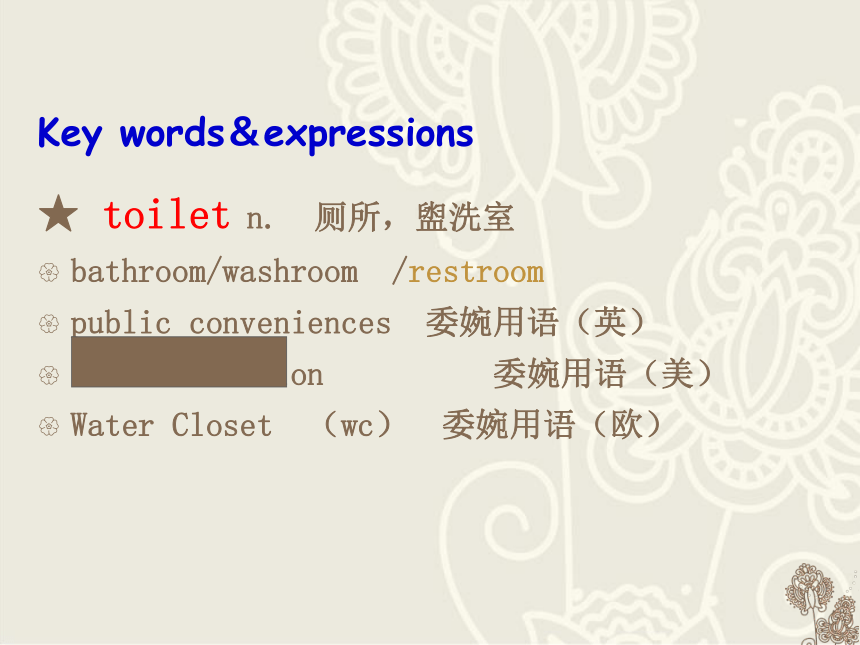

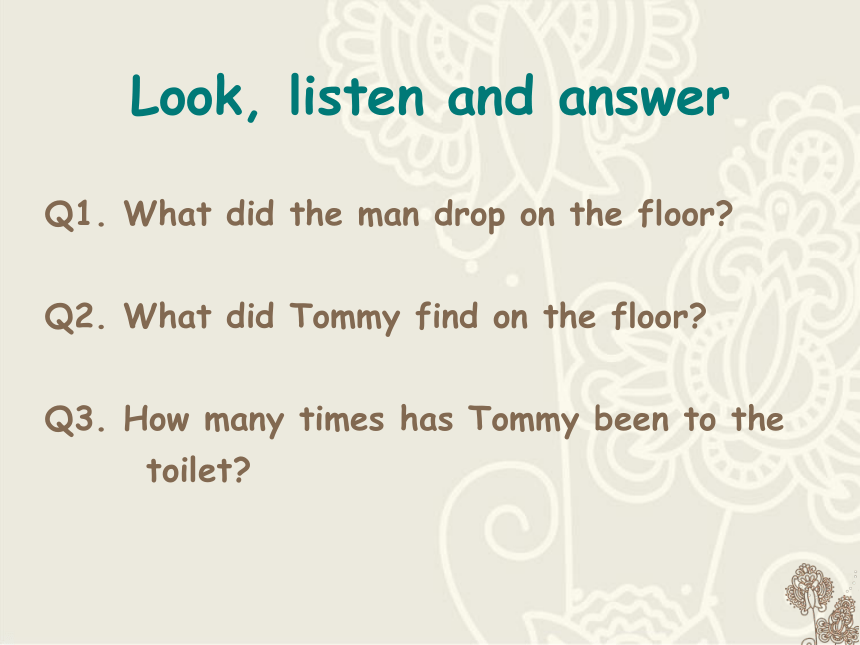
文档简介
(共48张PPT)
Lesson 117
Tommy's breakfast
汤米的早餐
New words
dinning room ['daini 'ru:m] 饭厅
coin [k n] n.硬币
mouth [ma θ] n.嘴
swallow ['sw l u] v.吞下
later ['le t ] adv.后来
toilet ['t l t] n. 厕所,盥洗室
Key words&expressions
dining room 饭厅
coin 硬币
mouth 嘴
swallow 吞下
later 后来
toilet 厕所
ring 响
dining room 饭厅
living room
起居室,客厅
bedroom
卧室
bathroom
洗浴室,卫生间
kitchen
厨房
coin n. 硬币(可数名词)
e.g. Every coin has two sides.
每个事物都有两面性。
coin n. 硬币 (note 纸币)
toss a coin 掷硬币(打赌正面或反面)
Pay a person back in his own coin.
以其人之道还治其人之身。
mouth n. 嘴
e.g. Don’t talk with your mouth full!
嘴里塞满食物时不要说话。
swallow v. 1)吞下,咽下
Tommy swallowed the coins.
2) n. 一口(一口的量)
take a swallow of beer 喝一口啤酒
at one swallow 一饮而尽
later
1) adv. 后来,较迟地,较后地
e.g. three days later
三天后
See you later. 回头见,再见。
sooner or later 早晚,总有一天
2)adj. 较迟的,较后的,更近的。
e.g. Let’s take a later train.
我们搭晚一点的火车吧。
Key words&expressions
★ toilet n. 厕所,盥洗室
bathroom/washroom /restroom
public conveniences 委婉用语(英)
comfort station 委婉用语(美)
Water Closet (wc) 委婉用语(欧)
Time for listening!
Q1. What did the man drop on the floor
Q2. What did Tommy find on the floor
Q3. How many times has Tommy been to the
toilet
Look, listen and answer
When my husband
was going into
the dining room
this morning,
he dropped some coins on the floor.
Language points
1.When my husband was going into the dining room this morning, he dropped some coins on the floor.
此句为复合句,when引导时间状语从句,
说明故事发生的时间
从句
过去进行时:was/were + doing
强调过去某个时间正在发生的事。
go into 走进,强调“进入”的动作,反义词 go out of 走出…
主句为一般过去时,表示过去某一动作进行的同时发生了另外的情况
drop 掉下
小心,别把花瓶摔了。 Be careful! Don’t drop the vase.
时间状语从句引导词“当......时”
There were coins everywhere. We looked for them, but we could not find them all.
Language points
2. there were coins everywhere.
复合不定代词
Every No Any Some
One Everyone No one Anyone Someone
Thing Everything Nothing Anything Something
Body Everybody Nobody Anybody somebody
We looked for them, but could not find them all.
look for 寻找,强调动作。look是不及物动词。
find 找到,强调结果。find是及物动词。
例:I looked for the dog everywhere, and found it in the garden at last.
我到处找那只狗,最后在花园里找到了它。
all 用来强调每一个硬币。从语法上讲,all 是 them 的同位语,(紧跟在一个名词或代词后,进一步说明前面名词或代词是谁或什么东西)也可以说成 all of them 。them all= all of them
例:We all like apples.= All of us like apples.
could是can的过去式
While we were having breakfast,
Our little boy, Tommy, found two small coins on the floor.
4.While we were having breakfast, our little boy, Tommy, found two small coins on the floor.
在某事发生的同时,发生了某事。While引导的时间状语从句。
从句
were /was+动词ing 过去进行时
while时间状语从句引导词“当......时”
Tommy, 是our little boy的同位语,补充说明。
主句,
一般过去时
当孩子正在花园玩的时候,开始下雨了。
While the children were playing in the garden, it began to rain.
He put them both into his mouth,
we both tried to get the coins,
but it was too late.
Tommy had already swallowed them!
He put them both into his mouth.
put sth +介词短语 把…东西放在…
把书放在桌子上
Put the books on the desk.
both表示“两个都…”是them的同位语
他们俩都想去法国。
They both want to go to France.
三者或三者以上用all
他们大家都幸福
They were all happy.
both ,all用在人称代词之前时,必须加of,
即both /all+of +人称代词宾格(Both of you are right .)
We both tried to get the coins.
both是we的同位语
try to do sth .试图做某事
But it was too late.
Tommy had already swallowed them!
too,"太",具有否定意思,放在它所修饰的词前
had+动词的过去分词,过去完成时,
“表示动作发生在过去的过去”
Later that morning ,when I was doing the housework ,Bill phoned me from the office .
later that morning, when I was doing the housework, my husband telephoned me from the office.
后来,晚些时候
早些时候
earlier
给某人打电话
该句为when 引导的时间状语从句
从句
过去进行时表示
过去正在进行的动作。
主句为一般过去时表示比较短晢的动作或事情
‘How’s Tommy ’he asked .
‘I don’t know ,’I answered .
‘Tommy’s been to the toilet
three times this morning ,
but I haven’t had any change
yet .
‘How’s Tommy ’ he asked.
‘I don’t know,’ I answered,
直接引语
‘Tommy's been to the toilet three times
this morning, butI haven't had any change yet!’
but连接的并列句
has been to 去过某地
time 次数,(可数):
three times > twice > once
change 零钱 = coin
Change 变化
双关语
yet 用于完成时的否定句和疑问句中。
1. go into…
2. go out of…
3. look for
find
4. put…into…
5. both
all
6. later that morning
走进…
走出…
3.寻找(强调找的动作过程)
找到(强调找的结果)
4.把…放入…里
5.(两者)都
(三者或三者以上)都
6.那天上午的晚些时候
Phrases
7. have been to …
8. once
twice
three times
four times
9. while
10. when
7.去过某地
8. 一次
二次
三次
四次
9. 正当…时
10.什么时候/何时/ 当…时
Phrases
1. go into…
2. go out of…
3. look for
find
4. put…into…
5. both
all
6. later that morning
走进…
走出…
3.寻找(强调找的动作过程)
找到(强调找的结果)
4.把…放入…里
5.(两者)都
(三者或三者以上)都
6. 那天上午的晚些时候
Phrases
7. have been to …
8. once
twice
three times
four times
9. while
10. when
7.去过某地
8. 一次
二次
三次
四次
9. 正当…时
10.什么时候/何时/ 当…时
Phrases
When my husband was going into the dining room this morning, he dropped some coins on the floor.
While we were having breakfast, our little boy, Tommy, found two small coins on the floor.
Later that morning, when I was doing the housework, my husband phoned me from the office.
过去进行时:表示过去某一特定时刻正在进行的动作。
与现在进行时相比,过去进行时的区别就在于要用be的过去式。
一般时间状语从句由while , when , as等引导。说明句中动作发生的背景。
当一长一短的两个动作在过去某时同时发生时,用过去进行时表示较长的动作。过去进行时可用于主句,也可用于从句。
Focus on grammar
We looked for them, but we could not find them all.
While we were having breakfast, our little boy,
Tommy, found two small coins on the floor.
He put them both into his mouth.
We both tried to get the coins, but it was too late.
This bookcase isn’t for me. It’s for my daughter, Susan.
同位语:紧跟在一个名词或代词后,进一步说明前面名词或代词是谁或是什么东西的名词或代词, 叫同位语。
Focus on grammar
He put them both into his mouth. We both tried to get the coins, but it was too late.
Tommy had already swallowed them!
过去完成时:过去发生的两个动作中,发生在前的 那个动作用过去完成时。
Focus on grammar
What is he doing now
He is singing now!
What was he doing at the
concert
He was singing at the concert!
What was Carfiled doing
at 11 O’clock yesterday morning
Carfiled was cooking at 11
O’clock yesterday
morning.
Joe was reading a book.
Carfield was watching TV.
When Joe was reading a book,Carfield was watching TV.
while
概念:
1、在过去某个特定的时间正在进行或发生的动作。
2、当过去的一个动作发生的时候另外一个动作正在进行。
过去进行时
结构
1、肯定句:主语+was/were + 现在分词
I was having breakfast.
2、否定句:主语+was/were not +现在分词
They were not watching TV.
3、疑问句:was/were + 主语+ 现在分词
Was he writing a letter last night
1. 用法:
①过去某个时间正在发生的动作
例:He was cooking at six last night. 昨天晚上六点,他正在做饭。
②过去某段时间正在发生的动作
例:I was staying here from March to May last year. 去年从3月到5月,我一直呆在这里。
2.与过去进行时连用的时间状语,常见的有 at nine last night/ at that time= then/at this time yesterday,或有when the teacher came in/ while he was reading的提示
Grammar
3. 如果过去的两个动作同时发生,我们可以用when /while连接这两个同时发生的动作。译作“正当…的时候”.
例:
过去进行时与一般过去时
过去进行时强调过程,不一定完成
一般过去时强调事件,一定完成
I went to school yesterday.
I was going to school at that time.
Tom did his homework last week.
Tom was doing his homework at nine o’clock last night.
用所给动词的过去进行时填空:
1.He ___________(do)his homework at two o'clock
yesterday afternoon .
2.They _________(have)a meeting from 8 to 10
last night .
3.Mary ____________(watch)TV when I came in .
4.My wife __________(cook)while I________(work)
in the garden .
5.When I ________(brush) my teeth , the postman
arrived .
6Just as I ___________(buy)the ticket, the train left.
was doing
were having
was watching
was cooking
was working
was brushing
was buying
用所给动词的适当形式填空:
1. I ________(drive)to work at half past seven
yesterday morning .
2.I _________(talk ) with a friend when my mother
________(come)back.
3.Jim __________(leave)as the postman_______(arrive)
4.We _________(study)English when the electricity
_________(go) off
5.While my mother ______________(make)a cake ,I
__________(read)a book .
was driving
was talking
came
was leaving
arrived
were studying
went
were making
was reading
Lesson 117
Tommy's breakfast
汤米的早餐
New words
dinning room ['daini 'ru:m] 饭厅
coin [k n] n.硬币
mouth [ma θ] n.嘴
swallow ['sw l u] v.吞下
later ['le t ] adv.后来
toilet ['t l t] n. 厕所,盥洗室
Key words&expressions
dining room 饭厅
coin 硬币
mouth 嘴
swallow 吞下
later 后来
toilet 厕所
ring 响
dining room 饭厅
living room
起居室,客厅
bedroom
卧室
bathroom
洗浴室,卫生间
kitchen
厨房
coin n. 硬币(可数名词)
e.g. Every coin has two sides.
每个事物都有两面性。
coin n. 硬币 (note 纸币)
toss a coin 掷硬币(打赌正面或反面)
Pay a person back in his own coin.
以其人之道还治其人之身。
mouth n. 嘴
e.g. Don’t talk with your mouth full!
嘴里塞满食物时不要说话。
swallow v. 1)吞下,咽下
Tommy swallowed the coins.
2) n. 一口(一口的量)
take a swallow of beer 喝一口啤酒
at one swallow 一饮而尽
later
1) adv. 后来,较迟地,较后地
e.g. three days later
三天后
See you later. 回头见,再见。
sooner or later 早晚,总有一天
2)adj. 较迟的,较后的,更近的。
e.g. Let’s take a later train.
我们搭晚一点的火车吧。
Key words&expressions
★ toilet n. 厕所,盥洗室
bathroom/washroom /restroom
public conveniences 委婉用语(英)
comfort station 委婉用语(美)
Water Closet (wc) 委婉用语(欧)
Time for listening!
Q1. What did the man drop on the floor
Q2. What did Tommy find on the floor
Q3. How many times has Tommy been to the
toilet
Look, listen and answer
When my husband
was going into
the dining room
this morning,
he dropped some coins on the floor.
Language points
1.When my husband was going into the dining room this morning, he dropped some coins on the floor.
此句为复合句,when引导时间状语从句,
说明故事发生的时间
从句
过去进行时:was/were + doing
强调过去某个时间正在发生的事。
go into 走进,强调“进入”的动作,反义词 go out of 走出…
主句为一般过去时,表示过去某一动作进行的同时发生了另外的情况
drop 掉下
小心,别把花瓶摔了。 Be careful! Don’t drop the vase.
时间状语从句引导词“当......时”
There were coins everywhere. We looked for them, but we could not find them all.
Language points
2. there were coins everywhere.
复合不定代词
Every No Any Some
One Everyone No one Anyone Someone
Thing Everything Nothing Anything Something
Body Everybody Nobody Anybody somebody
We looked for them, but could not find them all.
look for 寻找,强调动作。look是不及物动词。
find 找到,强调结果。find是及物动词。
例:I looked for the dog everywhere, and found it in the garden at last.
我到处找那只狗,最后在花园里找到了它。
all 用来强调每一个硬币。从语法上讲,all 是 them 的同位语,(紧跟在一个名词或代词后,进一步说明前面名词或代词是谁或什么东西)也可以说成 all of them 。them all= all of them
例:We all like apples.= All of us like apples.
could是can的过去式
While we were having breakfast,
Our little boy, Tommy, found two small coins on the floor.
4.While we were having breakfast, our little boy, Tommy, found two small coins on the floor.
在某事发生的同时,发生了某事。While引导的时间状语从句。
从句
were /was+动词ing 过去进行时
while时间状语从句引导词“当......时”
Tommy, 是our little boy的同位语,补充说明。
主句,
一般过去时
当孩子正在花园玩的时候,开始下雨了。
While the children were playing in the garden, it began to rain.
He put them both into his mouth,
we both tried to get the coins,
but it was too late.
Tommy had already swallowed them!
He put them both into his mouth.
put sth +介词短语 把…东西放在…
把书放在桌子上
Put the books on the desk.
both表示“两个都…”是them的同位语
他们俩都想去法国。
They both want to go to France.
三者或三者以上用all
他们大家都幸福
They were all happy.
both ,all用在人称代词之前时,必须加of,
即both /all+of +人称代词宾格(Both of you are right .)
We both tried to get the coins.
both是we的同位语
try to do sth .试图做某事
But it was too late.
Tommy had already swallowed them!
too,"太",具有否定意思,放在它所修饰的词前
had+动词的过去分词,过去完成时,
“表示动作发生在过去的过去”
Later that morning ,when I was doing the housework ,Bill phoned me from the office .
later that morning, when I was doing the housework, my husband telephoned me from the office.
后来,晚些时候
早些时候
earlier
给某人打电话
该句为when 引导的时间状语从句
从句
过去进行时表示
过去正在进行的动作。
主句为一般过去时表示比较短晢的动作或事情
‘How’s Tommy ’he asked .
‘I don’t know ,’I answered .
‘Tommy’s been to the toilet
three times this morning ,
but I haven’t had any change
yet .
‘How’s Tommy ’ he asked.
‘I don’t know,’ I answered,
直接引语
‘Tommy's been to the toilet three times
this morning, butI haven't had any change yet!’
but连接的并列句
has been to 去过某地
time 次数,(可数):
three times > twice > once
change 零钱 = coin
Change 变化
双关语
yet 用于完成时的否定句和疑问句中。
1. go into…
2. go out of…
3. look for
find
4. put…into…
5. both
all
6. later that morning
走进…
走出…
3.寻找(强调找的动作过程)
找到(强调找的结果)
4.把…放入…里
5.(两者)都
(三者或三者以上)都
6.那天上午的晚些时候
Phrases
7. have been to …
8. once
twice
three times
four times
9. while
10. when
7.去过某地
8. 一次
二次
三次
四次
9. 正当…时
10.什么时候/何时/ 当…时
Phrases
1. go into…
2. go out of…
3. look for
find
4. put…into…
5. both
all
6. later that morning
走进…
走出…
3.寻找(强调找的动作过程)
找到(强调找的结果)
4.把…放入…里
5.(两者)都
(三者或三者以上)都
6. 那天上午的晚些时候
Phrases
7. have been to …
8. once
twice
three times
four times
9. while
10. when
7.去过某地
8. 一次
二次
三次
四次
9. 正当…时
10.什么时候/何时/ 当…时
Phrases
When my husband was going into the dining room this morning, he dropped some coins on the floor.
While we were having breakfast, our little boy, Tommy, found two small coins on the floor.
Later that morning, when I was doing the housework, my husband phoned me from the office.
过去进行时:表示过去某一特定时刻正在进行的动作。
与现在进行时相比,过去进行时的区别就在于要用be的过去式。
一般时间状语从句由while , when , as等引导。说明句中动作发生的背景。
当一长一短的两个动作在过去某时同时发生时,用过去进行时表示较长的动作。过去进行时可用于主句,也可用于从句。
Focus on grammar
We looked for them, but we could not find them all.
While we were having breakfast, our little boy,
Tommy, found two small coins on the floor.
He put them both into his mouth.
We both tried to get the coins, but it was too late.
This bookcase isn’t for me. It’s for my daughter, Susan.
同位语:紧跟在一个名词或代词后,进一步说明前面名词或代词是谁或是什么东西的名词或代词, 叫同位语。
Focus on grammar
He put them both into his mouth. We both tried to get the coins, but it was too late.
Tommy had already swallowed them!
过去完成时:过去发生的两个动作中,发生在前的 那个动作用过去完成时。
Focus on grammar
What is he doing now
He is singing now!
What was he doing at the
concert
He was singing at the concert!
What was Carfiled doing
at 11 O’clock yesterday morning
Carfiled was cooking at 11
O’clock yesterday
morning.
Joe was reading a book.
Carfield was watching TV.
When Joe was reading a book,Carfield was watching TV.
while
概念:
1、在过去某个特定的时间正在进行或发生的动作。
2、当过去的一个动作发生的时候另外一个动作正在进行。
过去进行时
结构
1、肯定句:主语+was/were + 现在分词
I was having breakfast.
2、否定句:主语+was/were not +现在分词
They were not watching TV.
3、疑问句:was/were + 主语+ 现在分词
Was he writing a letter last night
1. 用法:
①过去某个时间正在发生的动作
例:He was cooking at six last night. 昨天晚上六点,他正在做饭。
②过去某段时间正在发生的动作
例:I was staying here from March to May last year. 去年从3月到5月,我一直呆在这里。
2.与过去进行时连用的时间状语,常见的有 at nine last night/ at that time= then/at this time yesterday,或有when the teacher came in/ while he was reading的提示
Grammar
3. 如果过去的两个动作同时发生,我们可以用when /while连接这两个同时发生的动作。译作“正当…的时候”.
例:
过去进行时与一般过去时
过去进行时强调过程,不一定完成
一般过去时强调事件,一定完成
I went to school yesterday.
I was going to school at that time.
Tom did his homework last week.
Tom was doing his homework at nine o’clock last night.
用所给动词的过去进行时填空:
1.He ___________(do)his homework at two o'clock
yesterday afternoon .
2.They _________(have)a meeting from 8 to 10
last night .
3.Mary ____________(watch)TV when I came in .
4.My wife __________(cook)while I________(work)
in the garden .
5.When I ________(brush) my teeth , the postman
arrived .
6Just as I ___________(buy)the ticket, the train left.
was doing
were having
was watching
was cooking
was working
was brushing
was buying
用所给动词的适当形式填空:
1. I ________(drive)to work at half past seven
yesterday morning .
2.I _________(talk ) with a friend when my mother
________(come)back.
3.Jim __________(leave)as the postman_______(arrive)
4.We _________(study)English when the electricity
_________(go) off
5.While my mother ______________(make)a cake ,I
__________(read)a book .
was driving
was talking
came
was leaving
arrived
were studying
went
were making
was reading
同课章节目录
